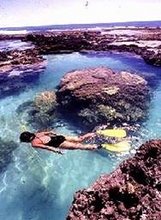 MEC’s* most successful seeding site is found in Bauan, Batangas. It is an over-fished reef that had been declared as a fish sanctuary in 1994 through the initiative of a resort. MEC conducted three seeding operations in 1996, 1998 and 2000. The partner-stewards are Dive and Trek resort and the Barangay San Pablo community.
MEC’s* most successful seeding site is found in Bauan, Batangas. It is an over-fished reef that had been declared as a fish sanctuary in 1994 through the initiative of a resort. MEC conducted three seeding operations in 1996, 1998 and 2000. The partner-stewards are Dive and Trek resort and the Barangay San Pablo community.Although the reef is a no-take zone, diving, swimming and snorkeling are allowed. Through the years, significant changes have occurred in the reef, resulting in benefiting not only the marine environment but also the partner-stewards and the other stakeholders. Changes include an increase in fish density and biodiversity, and recruitment of corals and other benthic organisms by the shells of the seeded giant clams. In a matter of six years, the over-fished reef that started out with very little fish became a very productive and stable ecosystem; increasing fish catch in the surrounding areas outside of the MPA.
Although the observed changes were mostly anecdotal, they have brought about benefits not just for the reef and its inhabitants but also to the people relying on it for livelihood and recreation. Other benefits include increased tourist traffic to the MPA. A place that was once visited only by SCUBA divers has now become a popular destination for families, groups locals and non-divers who wish to swim and snorkel to see a well-enhanced reef with giant clams, plenty of fish and marine creatures. This has translated into increased profit by the resort operator, as well as increased environmental awareness and appreciation of reef protection and management among the people.
*MEC stands for Marine Ecosystem Council, a volunteer organization co-founded by Louie and Chen in 1996.









No comments:
Post a Comment